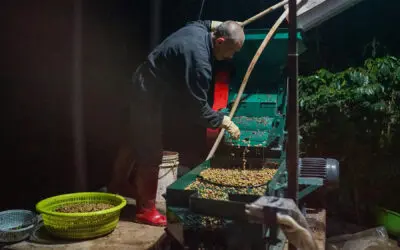Ever wondered why some coffees burst with bright, fruity notes while others deliver deep chocolate undertones? The secret lies not just in the beans themselves, but in how they’re processed.
Today, I’m pulling back the curtain on coffee processing methods that transform your morning brew from a humble cherry to the complex beverage you can’t start your day without.
The Natural Process: Nature’s Sweet Touch
Picture this: coffee cherries basking in the warm sun, slowly drying with their fruit intact. This traditional method, known as natural or dry processing, is coffee’s equivalent of wine fermentation. As the cherry’s sugars concentrate and interact with the bean, they create bold, sweet profiles with distinctive berry notes and a heavy, syrupy body. Ethiopian Yirgacheffe (my personal favourite) processed this way often explodes with blueberry flavours so vivid, you’ll wonder if someone snuck fruit into your cup.
Washed Processing: The Clean and Bright Revolution
Think of washed processing as coffee’s purist approach. The cherry’s flesh is completely removed before drying, allowing the true character of the bean to shine through. This method gives us those crisp, bright cups with pronounced acidity and clarity that coffee aficionados love. That Colombian coffee with sparkling citrus notes and a clean finish? Thank the washing station that brought these qualities to the forefront.
Honey Processing: The Best of Both Worlds
Despite its name, no honey is involved – but the resulting cup is just as sweet. This method, where some fruit flesh remains on the bean during drying, creates a flavour profile that bridges the gap between natural and washed coffees. The amount of flesh left on determines whether it’s yellow, red, or black honey process, each offering increasing levels of sweetness and body. The “colour” names actually come from how dark the beans get during drying – the more mucilage left on, the darker they turn due to oxidation. The increased sugar content and longer drying times result in more complex chemical reactions, creating deeper, more nuanced flavour compounds. It’s like having your cake and eating it too – bright acidity meets fruity sweetness in perfect harmony. For a deeper understanding, see our article on the three grades of honey processing.
The Game-Changer: Experimental Fermentation
Here’s where coffee processing gets wild. Innovative producers are now experimenting with controlled fermentation, similar to wine and beer making. By manipulating variables like temperature, time, and the presence of specific yeasts, they’re creating cups with unprecedented flavour profiles. Imagine coffee that tastes like tropical fruit punch or has notes of Earl Grey tea – these aren’t fantasy, they’re the result of cutting-edge processing techniques.
Why This Matters for Your Daily Cup
Understanding processing methods doesn’t just make you a coffee expert at dinner parties – it revolutionizes how you choose and appreciate your coffee. That Ethiopian natural that was too “wild” for your taste? Now you know why it tastes that way, and might even appreciate its unique character. Looking for a clean, bright cup to start your day? Reach for a washed Central American coffee.
The next time you’re at your favourite coffee shop or browsing online retailers, look for processing information on the bag. It’s your secret weapon for predicting flavour profiles and finding your next favourite bean. Because in the end, coffee isn’t just about caffeine – it’s about experiencing the amazing complexity that careful processing can reveal.
Want to dive deeper into the world of coffee processing? Subscribe to our newsletter for weekly insights into what makes your coffee taste extraordinary, and follow us on social media for daily doses of coffee wisdom.



0 Comments